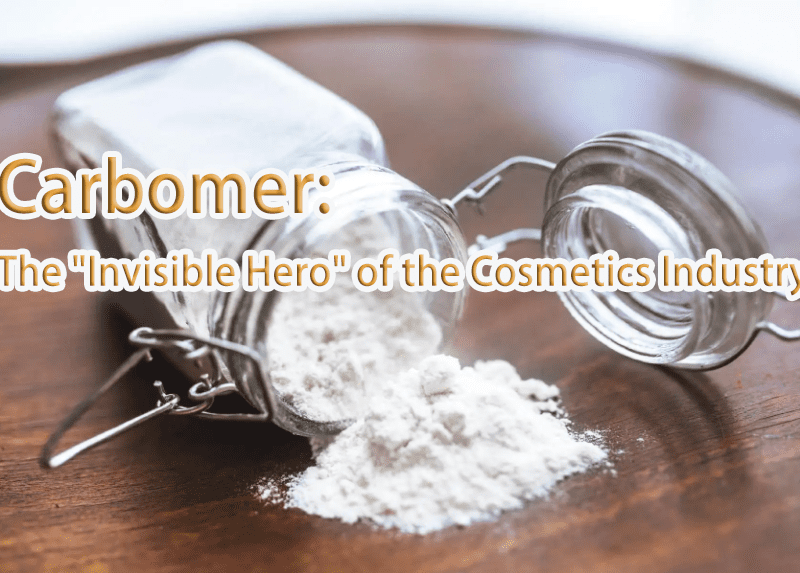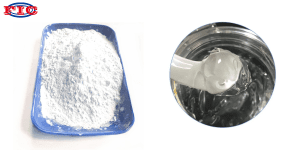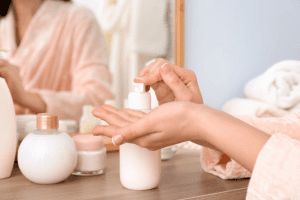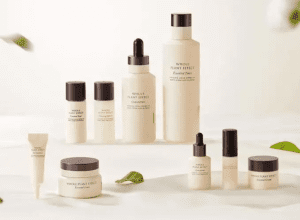
In the cosmetics industry, many ingredients may not be the focus of consumer attention, but their roles in product formulations are crucial. “Carbomer” is one such ingredient—low-key yet indispensable. Widely used in everything from lotions to gels and creams, it provides products with the ideal texture and stability. This article will introduce what carbomer is, its functions in cosmetics, and why it is so important in skincare and beauty products.
What is Carbomer?
Carbomer refers to a group of synthetic polymers made by cross-linking acrylic acid with other chemical compounds, usually appearing as a white powder. When combined with water, carbomer rapidly expands to form a clear gel, making it a popular choice in cosmetics as a thickening and gelling agent. Due to its excellent performance, carbomer is a fundamental ingredient in many formulations, particularly in liquid and gel-based products, where it enhances the texture and stability.
While the chemical structure of carbomer is complex, its use is relatively simple. Formulators need only dissolve a small amount of carbomer in water and adjust the pH to achieve a thickening effect. This makes carbomer an efficient ingredient in the cosmetics industry, as it imparts a light, transparent appearance and texture to products.

Main Functions of Carbomer in Cosmetics:
Carbomer is widely used in cosmetics due to its multifunctionality. Below are its core roles in cosmetic formulations:
1.Thickening Agent:
Carbomer’s most famous role is as a thickening agent. It can turn a liquid formula into a gel or cream, improving the product’s texture and flow. For example, in moisturizing gels, carbomer is often used to provide a light, jelly-like texture, making the product feel smooth when applied.
Thanks to carbomer’s strong thickening effect, formulators only need a small amount to achieve the desired texture. This not only reduces cost but also ensures product consistency, preventing the formulation from being too thick or too watery, thus enhancing user experience.
2.Suspending Agent:
Many cosmetic products contain particles or incompatible ingredients that don’t easily dissolve. Carbomer helps suspend these components in the product, preventing them from settling or separating. For example, in exfoliating gels with particles, carbomer ensures that the particles are evenly distributed without sinking to the bottom.
Additionally, in emulsions and creams that contain both water and oil, carbomer serves as a suspending agent, stabilizing the emulsion and ensuring that the product retains a consistent texture during storage
3.Emulsion Stabilizer:
In lotions and creams, where water and oil components are mixed, emulsifiers are required to keep them together. Carbomer acts as an emulsion stabilizer in these products. It not only helps maintain the mix of water and oil but also increases the viscosity, making the product smoother and easier to apply.
4.Gelling Agent:
Carbomer is an essential gelling agent in many gel-based products, such as moisturizing gels, eye serums, and hair styling gels. It forms a clear, lightweight gel texture, which is particularly suited for refreshing skincare and hair care products, avoiding greasiness or heaviness.
5.Rheology Modifier:
Another advantage of carbomer is its ability to modify the flow properties of a product, affecting how it behaves when applied. In a stationary state, carbomer makes the product thicker, while under pressure (e.g., when rubbed on the skin), the product becomes lighter and easier to spread. This “shear-thinning” property enhances the user experience, making products smoother and non-sticky during application.
Applications of Carbomer:
Carbomer is used in a wide range of cosmetics and personal care products, including:
1.Moisturizing Gels:
Carbomer is a staple in moisturizing gels due to its excellent gelling properties, providing a light, hydrating layer without feeling heavy or oily on the skin.
2.Sunscreen:
Many sunscreens use carbomer to thicken the formula while ensuring that the product can be easily applied and forms an even protective layer on the skin.
3.Eye Creams and Serums:
In these high-performance skincare products, carbomer helps maintain a lightweight texture while stabilizing active ingredients.
4.Cleansers:
In cleansers like face washes and cleansing gels, carbomer increases the viscosity while helping the cleansing agents spread evenly across the skin for better cleansing results.
5.Hair Care Products:
In hair gels and styling products, carbomer provides the right hold and texture, while ensuring the hair maintains a natural feel without becoming too stiff.

Safety of Carbomer:
As a synthetic polymer, carbomer is considered safe for use in cosmetics. According to multiple studies, carbomer is used in very low concentrations in cosmetic formulations (usually 0.1% to 1%), making it unlikely to cause skin irritation or allergic reactions. Carbomer is not absorbed into the skin, meaning it does not pose any risk to human health. Its safety has been recognized by the U.S. Food and Drug Administration (FDA) and the European Union’s cosmetic regulatory bodies.
In rare cases, carbomer may cause mild dryness. To counter this, formulators often combine carbomer with other moisturizing agents or emollients to ensure the overall comfort and hydration of the product.
Conclusion:
As an “invisible hero” in cosmetics, carbomer may not be the star ingredient in product advertisements, but it works behind the scenes to provide crucial support for product stability, texture, and user experience. Whether in moisturizing gels, sunscreens, cleansers, or styling gels, carbomer helps deliver the ideal texture and performance for these products. As the cosmetics industry continues to innovate, carbomer’s versatility and effectiveness will make it even more prevalent, enhancing the quality of skincare and beauty products for consumers everywhere.


